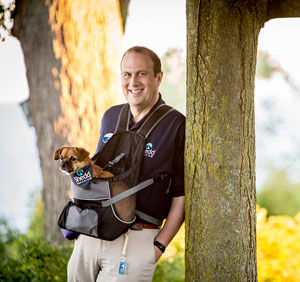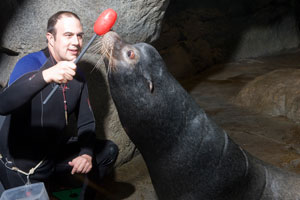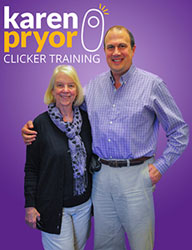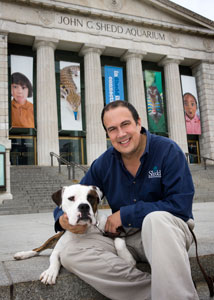“Animals deserve the best care that we can possibly provide.” That is the philosophy of 35-year animal training veteran and creative teacher and consultant, Ken Ramirez. Having worked with a dizzying number of species, including overseeing the care and training of more than 1500 species at Chicago’s Shedd Aquarium, Ken has developed a reputation for his ability to train any animal to do anything. Yet with each animal he trains, he never ceases to marvel at what these animals are capable of. From the most domestic pet to the most majestic marine mammal, Ken has learned valuable lessons that he has used to improve animal care all over the world through his seminars, research, writings, and as a regular speaker at ClickerExpo. As he embarks on what he describes as “perhaps the most important and impactful chapter of his career,” as the new Executive Vice President and Chief Training Officer at Karen Pryor Clicker Training (KPCT), we asked Ken to share his thoughts about past, present, and future—for him and for KPCT.

Photo credit:
Brenna Hernandez/Shedd Aquarium
How are the training challenges faced by people working in oceanariums or zoos the same as or different from the training challenges faced by people working with dogs?
I believe that training is training—and trainers of every species face the same challenges. How do we take what science has taught us and apply it to practical, real-world training? This is the dilemma or challenge that trainers of all species face. We have learned so much from the science of applied behavior analysis, but translating it to real-world training can be difficult. Whether you are training a dog or a horse, a dolphin or a tiger, finding skilled teachers that can help positive reinforcement trainers learn new techniques is also difficult. I always tell my students that whether you are training an earthworm or a Harvard graduate, the laws of learning are the same! But having said that, we still have to adapt our training to the unique needs of each species and each individual, and that will always be an ongoing challenge.
You have worked with a ridiculous number of species throughout your career. What have these animals taught you, both personally and professionally?
I have learned so much from every animal training partner I have ever had (animal and human). Simply put, I have learned that each is special and each is unique. I marvel at the wonder of nature and the lessons we can learn from the creatures around us.
You have worked so closely with so many animals in so many contexts. Are you still amazed by them? What parts are the most amazing? Emotional? Intellectual? Spiritual?

Ken with Biff, one of Shedd
Aquarium's resident California sea lions.
Photo credit:
Brenna Hernandez/Shedd Aquarium
I am absolutely amazed by every animal I meet! The physical adaptations of each species are special and unique, and create new challenges for us as trainers. The fact that some fly, some swim, some walk, and others crawl, slither, or hop both challenges and amazes me as a trainer. The variety of food animals eat, and the way they eat, is a marvel that never ceases to intrigue me. But perhaps even more incredible are the other aspects of working with animals that provide insights into their lives. For example, animals never lie! When animals behave a certain way, whether that is playfully, aggressively, or otherwise, we are experiencing their true emotional states. If we are wise enough to read and understand that behavior, it can give so much insight into that individual animal.
When did you know that you wanted to become part of KPCT, and what was the impetus behind that move?
I have been connected to KPCT for quite some time. I have been on the ClickerExpo faculty since the first Expo more than 10 years ago. I was invited to advise and participate in the creation of Karen Pryor Academy (KPA) as it was being developed. So, I have had the opportunity to get to know the mission and values of the organization, and have always recognized a strong parallel between those values and my own. After Karen celebrated her 80th birthday, she and KPCT President Aaron Clayton began discussing how best to continue the vision and mission of KPCT when Karen was ready to retire, or at least take a less active role in the day-to-day activities of the organization. Almost two years ago, they brought me into that conversation and asked me if I might be interested in helping guide KPCT into the future. Because of the shared mission, vision, and values, and because of the excellent reputation that KPCT has already established, the idea of joining the company was intriguing. I had to do some internal reflection and consider what was right for me personally, but ultimately I realized that joining KPCT was the next, and perhaps most important and impactful, chapter in my career.
KPCT’s mission is to help people “train better.” That mission seems central to your life’s work as well. Was that part of the attraction of coming to KPCT? How do you see the KPCT platform as a way to fulfill and expand this goal?
There is no question that the goal of helping people to “train better” is central not only to KPCT but to me personally. I am such a strong advocate for positive reinforcement training and the need to help people who love and care about animals improve their training skills. The KPCT platform will allow me to continue and expand on what Karen has built. I believe that there are many people that we need to reach, from improving the training of current positive reinforcement trainers to exposing more traditional trainers to the value of positive reinforcement —and helping to make it easier for them all to apply the technology effectively in their training programs. KPCT’s reach already goes beyond the dog world, but I hope to continue that reach and help trainers of all species (exotic or domestic) “train better.”

Continuing the legacy:
Karen and Ken
Welcoming you to KPCT at this time is, in effect, passing the torch of leadership for the clicker training movement from Karen to you; is that a lot of pressure?
Absolutely! It’s a great deal of pressure for two reasons. First, because it is such an important mission, and second, because Karen is such an icon. Fortunately, because I have worked with Karen for so long and because of the wonderful team she has created at KPCT, I feel confident moving forward. Much of what I will be responsible for is a continuation of the work I have been doing for decades; KPCT just gives me a bigger platform and a new audience to do that work.
How do you characterize Karen’s legacy?
I think Karen has single-handedly had the most significant impact on animal training of any other individual in modern times. Her book, Lads Before the Wind, first published in 1975, continues to be required reading for all marine mammal trainers and was the only popular resource available on positive reinforcement training for professional trainers for many years. When Karen wrote Don’t Shoot the Dog, the book brought her to the attention of the dog training world. That book is still in print in more than a dozen languages, and is probably the only book that you can find on the shelves of trainers from so many different arenas (dog training, cat training, horse training, marine mammal training, and zoo training)! As if that was not enough, her more recent book Reaching the Animal Mind makes the latest advances in positive reinforcement training very accessible to the public. These three books are only the tip of the iceberg. Karen has published and continues to publish scientific articles on animals and behavior. Of course the creation of KPCT has given her a huge platform to carry her legacy forward. The positive reinforcement torch has been and will continue to be carried by many great trainers, but Karen has had one of the most profound and lasting impacts on that growing community.
What pieces of Karen’s legacy are most important to maintain? Where do you hope to build or accelerate?
There are two qualities or abilities that have always impressed me about Karen. First has been her ability to communicate clearly and effectively to anyone about positive reinforcement training. It is one of the reasons that her books and the ClickerExpo conferences are so popular. Karen is skilled at educating people in clear, easy-to-understand language. The second impressive factor has been Karen’s accessibility, generosity, and willingness to share with anyone and everyone—this is how and why I got to know her at such an early point in my career. As I have worked with Karen in more recent years, I have recognized a third factor, which is her desire to stay current and continue advancing the science and the practical ways to apply the science. I hope that under my leadership I can continue to follow all three of these principles. I want to assist in expanding KPCT’s reach, still maintaining the core values for which Karen is so well known.
What message do you have for all the people who have been followers of Karen Pryor and a part of this movement for so long?
I would like to thank them for their support and assure them that the Karen Pryor name will continue to stand for excellence in positive reinforcement training. Our goal will always be to help people train better. Although Karen has stepped down from her current role at KPCT, she remains active in the company and will continue to have an impact and influence on the direction of the organization. I welcome feedback and suggestions; as a training community we are stronger when we share and speak with a united voice.
You incorporated shelter dogs into your work at Shedd. Do you see opportunities to expand in this area through your work with KPCT?

Ken with Nico, one of the
shelter dogs that Shedd adopted.
Photo credit:
Brenna Hernandez/Shedd Aquarium
One of the goals of bringing shelter dogs into the aquarium was to highlight training techniques and allow our guests to see that even dogs that have been abandoned and given up for behavioral reasons can do well if given a positive reinforcement environment. At KPA we offer a course called Shelter Training & Enrichment, and we want to continue to provide resources for those working in shelters. We will continue to educate people about training and the importance of training for all pets.
Over the span of your 35-year career, you have made a significant impact on the way people view animals and their intelligence. How do you see those contributions evolving in your new role?
I plan to continue my work with training animals of all species and to further some of the research I have done investigating the cognitive abilities of all animals. My hope is to integrate that work into various aspects of KPCT, perhaps as new seminars at ClickerExpo, new expanded courses through KPA, consulting opportunities, or the publication of new articles and books.
Currently, you consult with and speak at zoos and oceanariums all over the world. Will you continue to do that?
Yes, we will be expanding some of the educational and other services that we offer through KPCT. This expansion will allow me to continue my work with zoos, aquariums, and professional dog programs, and in other areas where positive reinforcement training education is needed.
Your career is rooted in dog training, having started out training guide dogs for the visually impaired. Would you say that in your new role you have come full circle?
Yes, I do feel like I have come full circle and that is due in large part to my involvement in KPCT. About 15 years ago, I began consulting with several search and rescue organizations. After Karen invited me to join the ClickerExpo faculty, my work and training were exposed to a much larger segment of the dog training world. That exposure led me to consulting projects with several guide dog organizations. I think that instead of it being a “full circle” process it has been more of an evolution. The type of training being done today is far more advanced and completely focused on positive reinforcement. The work I have done over the last few years with professional dog training groups is far different from what I was exposed to as a young trainer more than 40 years ago! I am looking forward to where training evolves and progresses to in the decades ahead.
You’ve been inspiring ClickerExpo attendees for almost a decade. What can we anticipate from you at ClickerExpo 2015?
For ClickerExpo 2015 I will be a part of the faculty and will serve in my new role with KPCT. As the new Executive Vice President and Chief Training Officer at KPCT I will be part of an opening talk with KPCT President Aaron Clayton. I plan to talk about the value I see in ClickerExpo, how to get the most from the conference, and how to carry what you learn home when you leave. I will also be conducting an “Interview with Karen.” Finally, I will have a private session with the KPA Certified Training Partners to get to know them, and allow them to get to know me.
In the Sessions that I lead I will continue my series on concept training. Last year I introduced the idea of “counting” and I have taken that even further this year; I will also be conducting a Lab on the topic. Last year I debuted a talk on scent discrimination training and reviewed the various approaches and challenges to working with scent; I will be presenting on that topic as well in 2015. In addition, I will conduct a Lab on non-food reinforcers.
It will be a busy Expo for me, but I wouldn't have it any other way!
Thank you, Ken. We look forward to working with you at KPCT, KPA, and ClickerExpo. We can’t wait to see what the future holds for Karen Pryor Clicker Training—and for animal training!


Post new comment